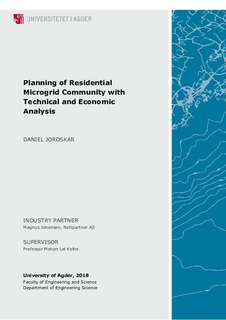| dc.description.abstract | Establishment of microgrid communities in Norway can contribute to solve many upgrading
challenges of the existing grid. Today's grid are in many areas not suited to handle both bidirec-
tional power
ow and the increasing consumption from the consumers. With great progress in
the development of PV systems, wind turbines and other DG units, is it necessary to establish
sustainable solutions to handle the impact this components has on the grid. Since its easier to
integrate DG units in microgrids, than in traditional distribution networks, can microgrid be a
sustainable solution that is bene cial for both consumers and distribution system operator.
The thesis consists of both a literature study involving microgrid technologies and barriers for
microgrids to develop in Norway, and a sustainable plan for a residential microgrid in Linnheia
in Aust-Agder. Block Watne AS has a local agreement to develop area regulations of Linnheia
Nord, and its desirable to investigate, in cooperation with Nettpartner AS, the opportunity of a
residential microgrid in one part of the area that is 4000m2 and will consist of 40 family houses.
The microgrid planning is based on the planning book of power grids from Sintef, and guidelines
for planning of microgrids developed by International Electrotechnical Commission.
Three di erent grid-connected microgrid scenarios are simulated and optimized in the soft-
ware Homer Energy. Every scenario consists of building integrated PV systems on the house
roofs, and the microgrid is optimized with and without wind turbines with a minimum of three
turbines. One scenario has a district heating system with a CHP micro-gas turbine, the second
scenario has geothermal energy storage, while the last scenario do not have any heating system.
The simulations showed that it might be advantageous to plan a microgrid based on a
heating system to cover space heat and/or hot water. This will be an adjustable component
that is very suitable for a microgrid that consists of several DG units. The heating system covers
the heating demand, which decreases the total consumption in the microgrid. This makes both
wind turbines and battery ESS super
uous in Linnheia Microgrid.
Further investigation on cost expands of the heating system, and also clari cations with the
DSO is necessary to develop the microgrid plan further. The software Homer Energy also makes
some simpli cations in the simulations and a detailed load forecast must be created. | nb_NO |

